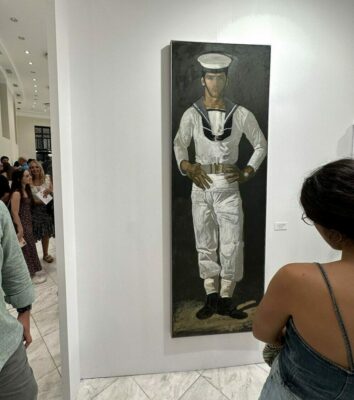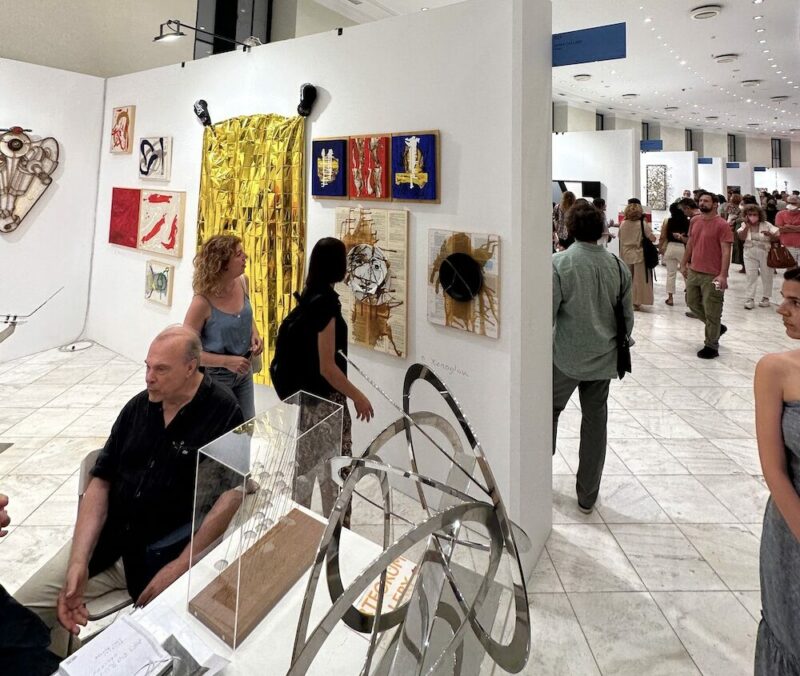Search
To search for an exact match, type the word or phrase you want in quotation marks.
A*DESK has been offering since 2002 contents about criticism and contemporary art. A*DESK has become consolidated thanks to all those who have believed in the project, all those who have followed us, debating, participating and collaborating. Many people have collaborated with A*DESK, and continue to do so. Their efforts, knowledge and belief in the project are what make it grow internationally. At A*DESK we have also generated work for over one hundred professionals in culture, from small collaborations with reviews and classes, to more prolonged and intense collaborations.
At A*DESK we believe in the need for free and universal access to culture and knowledge. We want to carry on being independent, remaining open to more ideas and opinions. If you believe in A*DESK, we need your backing to be able to continue. You can now participate in the project by supporting it. You can choose how much you want to contribute to the project.
You can decide how much you want to bring to the project.

While most conscious entities are aware of Greece’s recent challenges, from summer fires and floods to an overwhelming refugee crisis and a political shift to the right, Athens’ contemporary art scene remains a source of palpable and reassuring vitality. This is the same city whose ancient culture profoundly influenced Western civilization, and it continues to fascinate with its energy and vibrant contemporary art community. Amidst notable benefactors and influential patrons, it’s the dedicated art gallery owners, united under the Hellenic Galleries Association, who shape the city’s contemporary art identity. They orchestrate the country’s largest art event, the International Contemporary Art Fair Art Athina, which recently celebrated its 30th anniversary and stands as one of Europe’s oldest art fairs.
The vibrancy of Art Athina 2023 was embodied in its enthusiastic crowds. Everyday visitors were in abundance, alongside local artists, art professionals & enthusiasts. The event was hosted at the Zappeion Megaron. This architectural masterpiece, a neoclassical gem designed by Danish architect Theophil Hansen in 1874, served as a testament to the revival of classical aesthetics in a country steeped in the legacy of its once-mighty classical civilization. This architectural neoclassic after the classic “nutshell”, whatever it adds or subtracts from the meaning of the contemporary, encapsulated contemporary art for four days, from September 14th to the 17th.

Focusing on the people who shape the here and now, Marina Fokidis, artistic direction consultant for Art Athina 2023 and “crème de la crème” of the local contemporary art scene, has been both a curator of exhibitions at Art Athina and a spectator throughout its three decades of existence. In her words, “Art Athina epitomizes thirty years of “art-living,” sustainability, and relentless dedication.” Fokidis’ deep involvement in the Greek and international art scenes has granted her a comprehensive understanding of contemporary art and everything in between. With her extensive experience, she excels in identifying highlights and trends within the art world, offering valuable anthropological insights, and providing thoughtful considerations on the broader political landscape.
From established contemporary Greek artists like Chryssa at Mihalarias Art, Yannis Tsarouchis at Roma Gallery (whose work “Sailor in the Sun” from 1966, after confirmation by the Roma representative in their booth, sold for a remarkable €1 million), and George Lappas at Citronne, to young and internationally acclaimed figures such as Iris Touliatou at Rodeo, or the promising Olga Migliaressi Phoca at THE BREEDER, as well as a host of emerging talents, Art Athina thrives with intergenerational diversity . Many of these newcomer artists found their place in the Projects Spaces section, curated by Olympia Tzortzi, a project space founder herself and barely 30 years old. Tzortzi’s innovative perspective challenged conventional exhibition norms and aimed to establish flexible and dynamic multitasking exhibition models. This initiative culminated in the formation of a core group of projects which included up-and-coming artists like Pantelis Vitaliotis and Dimitris Fragakis at Space52, which presented the stimulative exhibition “Metamorphosis Unveiled.” The remaining projects featured in this section included Alkinois, igni office, koraï space, MISC, One Minute Space, Sealed Earth, and Thermia Project.
What appeared to be lacking were international galleries; out of the 59 galleries participating, the majority were Greek galleries primarily showcasing Greek artists. About 20% of the galleries represented international counterparts from nine different countries, with a notable presence from North and Central European nations such as Germany, the Netherlands, France, Switzerland, and the UK. The neighboring Cyprus and Eastern European countries, including Poland and Romania, were also represented.
The incorporation of the emerging generation of curators has proven to be highly effective. Danai Giannoglou‘s curated talks at Art Athina sparked dynamic dialogues, bridging diverse perspectives and fostering mutual learning, serving as the cornerstone of this artistic journey. Panos Giannikopoulos, who has been appointed curator of the forthcoming Greek pavilion at the Venice Biennale 2024, curated captivating gallery-based performances for Art Athina. These actions ventured into diverse artistic directions, embracing alternative mediums, and exploring the dynamic between materiality and digital realms.
On his side, Akis Kokkinos curated the video program, titled “I Miss You More Than I Remember You,” transforming the Zappeion Gardens into an open-air cinema. This initiative showcased moving-image works, documentaries, and fictional films by artists from Greece, Cyprus, Turkey, and Lebanon. The program collectively unveiled intricate narratives about land and vulnerable communities in the southeastern Mediterranean and Middle East, amplifying the voices and experiences of marginalized individuals.
Art possesses a unique ability to capture the essence of a moment, foster a critical spirit, and visually articulate the zeitgeist of its era. Art exhibitions ideally provide spaces for observation and freedom. However, art fairs also serve as unorthodox exhibitions, characterized by their heterogeneous display, arrangement, and aesthetic allure. Hence, the bipolarity of art fairs lies in their susceptibility to influence by political, economic, and social factors while simultaneously existing as their own microcosm. That is, the context and structure of art fairs are often intertwined with the presentation of art as commodities, and in some cases, even as assets, within an enclosed environment.
Undoubtedly, art fairs have ascended to prominence as pivotal fixtures in the global art market. As Paco Barragán described in his 2008 publication, “The Art Fair Age,” these ubiquitous events worldwide serve as essential platforms for art sales and exhibitions. Furthermore, within the context of the Mediterranean, where the severe regional crisis is exacerbated by the global corporatization of mega art fairs such as Art Basel —and its numerous offshoots (the most recent being the acquisition of Paris+), questions arise regarding the status of smaller art fairs, such as Art Athina.
Is there an alternative path for niche art fairs of this kind? Will they be absorbed by the behemoth, or will they manage to preserve their distinctive identity? One might contend that small and midsize fairs (along with small and midsize galleries, if we expand this analogy) can be likened to the intermediate stratum of today’s art landscape. They face challenges related to financial sustainability and stability, yet they they play a pivotal role in nurturing regional art creation and discourse. Perhaps it’s worthwhile to reassess their organizational framework and goals for the long term, obviously keeping in consideration the external economic and political factors mentioned earlier.
To frame it in a more positive perspective, how could we endorse a shift away from this fragile cultural structure that surrounds these events? If the success of art fairs is rooted in their network-based configuration, let’s delve deeper into what “network” means in this context. “Network” in the art world encompasses three crucial facets: firstly, it serves as a web connecting art dealers, professionals, and collectors across distant regions, thus creating a small-world network. Secondly, it functions as a network characterized by mutual observation. Lastly, it serves as a network whose outcomes, including sales and the introduction of emerging artists, set standards for other market participants, enticing them to join this interconnected web and nurturing connections within the art market.
Many suggests that Athens is on its way to becoming the new Berlin in the art world. Looking back at Berlin’s art scene from two decades ago, it has evolved into a vibrant hub for art sales… hence, indeed, the international art community is progressively turning its attention towards Athens art scene.
(Cover photo: Yannis Tsarouchis, “Sailor in the Sun,” 1966 at Roma Gallery. Oil on Canvas, 210 x 70 cm. Photo: Fotis Vallatos)
More information on Art Athina here.

Art Fair view, photo: Fotis Vallatos

María Muñoz-Martínez is a cultural worker and educator trained in Art History and Telecommunications Engineering, this hybridity is part of her nature. She has taught “Art History of the first half of the 20th century” at ESDI and currently teaches the subject “Art in the global context” in the Master of Cultural Management IL3 at the University of Barcelona. In addition, while living between Berlin and Barcelona, she is a regular contributor to different media, writing about art and culture and emphasising the confluence between art, society/politics and technology. She is passionate about the moving image, electronically generated music and digital media.
Portrait: Sebastian Busse
"A desk is a dangerous place from which to watch the world" (John Le Carré)